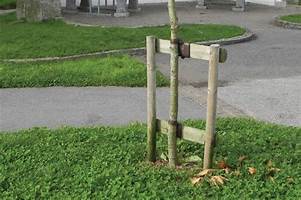Written by Jennifer Noonan and Bob Vila and published on https://www.bobvila.com/
Planting large trees is great for adding coverage in a garden or yard, and it is important to provide them with extra support through staking, should they need it. New trees or those that have sustained damage might need some extra support, so you should use stakes to help them grow strong and large. There are several methods of staking that will work best for your tree depending on its size and root system.
Table of Contents
How To: Stake a Tree
That newly planted member of your yard may need some help to grow up big and strong.

Most new trees do just fine on their own. In fact, the movement they experience from normal wind and weather helps these yard young’uns develop strong root systems and solid trunk girth. In several scenarios, however, it’s beneficial, even necessary, to stake a tree during its first growing season. If your new tree is planted on a slope or in an open area, or if it will be exposed to very strong winds, it may require some temporary stabilization. A young tree with a dense crown of leaves but a disproportionately small root ball may also require a stake. But trees must be staked properly, or damage—even death—can occur. This guide will help your new tree become a truly upstanding citizen!

STEP 1: Get the goods.
You’ll need two stakes per tree, plus straps to tie them to the trunk. To DIY your own stakes, taper the points of 6- to 8-foot long, 2×2 pieces of lumber, and use wire housed inside rubber hosing for ties. Or you can purchase stakes, made of treated wooden posts, and nylon or rubber ties from big box home improvement stores or nurseries.
STEP 2: Drive the stakes.
Place each stake on opposite sides of the tree, about 15 to 18 inches away from the trunk, ensuring they will clear the root ball. Drive each stake into the ground with a sledgehammer, about 18 inches deep.
STEP 3: Pick the right spot.
In general, to anchor trees exposed to high winds or on slopes, the straps should be placed about 18 inches above the ground. In the case of a tree with a flimsy trunk that can’t support itself, place the straps about 6 inches above the spot where the tree can stand upright.ADVERTISEMENT
STEP 4: Support the trunk.
Tie the tree to each stake with flat tree staking straps, so that they are taut but not so tight that the tree cannot move. You want to let the tree sway a bit in the wind, which encourages strong root development. Flat straps provide a large surface area to distribute pressure and avoid damage to the trunk. Be especially cautious if using homemade wire-in-hose straps: Stretch them too tight and they’ll injure the sensitive tissues just under the bark, essential for taking up water and nutrients.
STEP 5: Untie in a timely manner.
Remember, you should only stake a young tree for one growing season, until the root system has had a chance to spread out and set in. After removing the straps, you can leave the stakes in the ground as protection from foot traffic and lawn equipment if they don’t pose a hazard. If you choose to remove the stakes, dig gently around the base of each one to loosen it, being careful not to disturb the roots. Keep your straps and stakes if they are still in good condition to be used for the next tree you plant that requires staking.
With good care and a little luck, your new trees should bring joy to your family and beauty to your property for generations.
Original post here https://www.bobvila.com/articles/how-to-stake-a-tree/.

